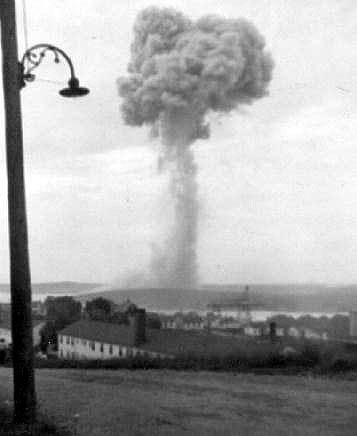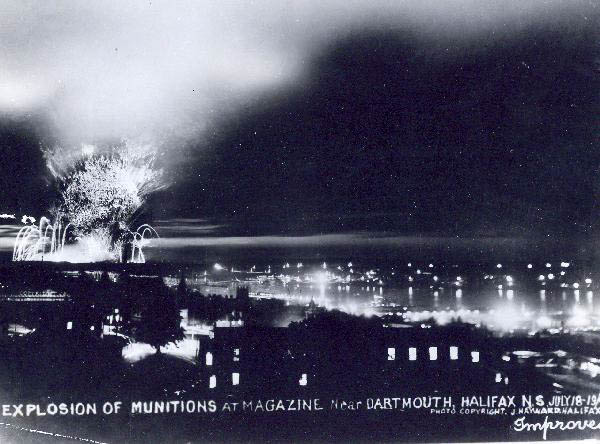I am sure that all of you have heard of the Halifax Explosion of 1917. While the Halifax Explosion of 1917 was a calamity, it was not the only major wartime explosion suffered by the locals. Most people believe that World War II ended with V day on 8th May 1945, but the reality was that, after the resolution in Europe, war continued in the Pacific. While most Canadians returned home following VE day, people and material moved to the Pacific theatre.

Halifax Explosion of 1945
Atlantic vessels were refit for their new duties in the Pacific. As part of the refit process, all ammunition was removed from ships in port. The ammunition was stored in the Canadian Naval Ammunition Storage Depot at Bedford Basin, just inland from the main port of Halifax.
July 18, 1945 was a fairly peaceful night in Halifax. However at about 6:30 PM, the calm was broken by a tremendous and earth moving flash and explosion. What was once the Depot was now a mushroom cloud billowing up to the heavens.
Ammunition and small explosives “pickled off” throughout the night and by midnight the “show” seemed to be over. A final bright and loud explosion almost precisely at midnight announced the end of the display.
The last report on the explosion stated that a fire, of unknown origin, which started on the dock, had spread to the ammunition depot. Although there was only one casualty (a workman who was on the jetty at the time of the first explosion) and very few injured, the explosion brought back dark memories for the local population. Up to 15,000 people in Halifax and another 10,000 in Dartmouth spent the night in parks, well away from the effects of the explosions.
But it could have been worse as some 50,000 depth charges were reportedly saved from the fire.
A number of eyewitness reports tell of the calamity caused by the explosion:
Janet Gorden was a very scared seven-year old kid living one block south of Quinpool. She recalls: “None of the storage buildings, which were full, caught fire, nor did they explode – the munitions stored outside is what went up as a result of a brush fire generated by the first explosion on the jetty – as the fire reached each dump and the firefighters retreated to safety, that dump went up; these explosions continued until close to 4 AM at which time there was a very large blast, but the fire was brought under control at about that time, avoiding the explosion of a very large dump of depth charges.”Russell McManus was a seven-year old: “I was sitting on a radiator next to an open window when the first boom went off and it blew me off the radiator unto the floor. My Father, a Master Gunner, was at the ammo dump a few days earlier inspecting the storage of artillery shells and he said that if the dumps had not been designed to blow up instead of sideways there would have been a lot more damage. Anyway we spent several hours on the Halifax commons and spent the night in the Halifax Armory.”
Janet Golden
In 1995, some 50 years after “Halifax Explosion II”, the military began to remove some of the ammunition that fell into the harbor. They used the subtle method of blowing it all up. Could that be called Halifax Explosion III?
Learn more at: https://mysteriesofcanada.com/military/halifax-explosion-of-1945/








